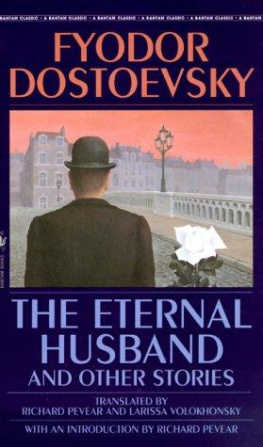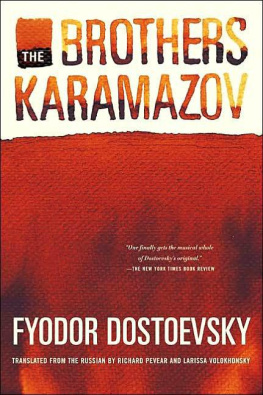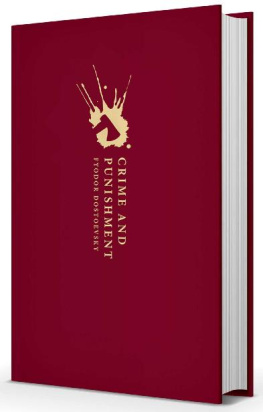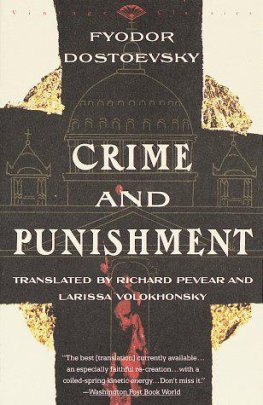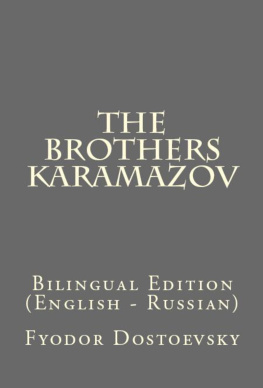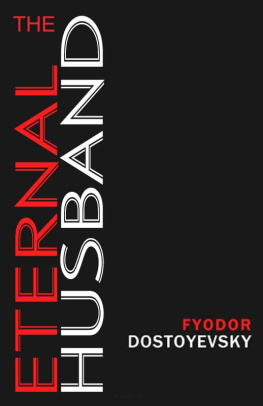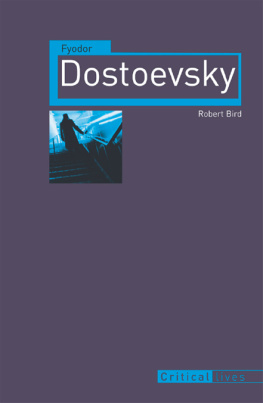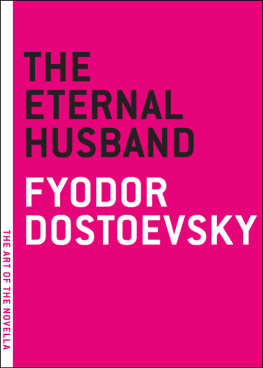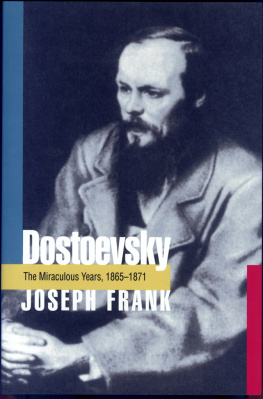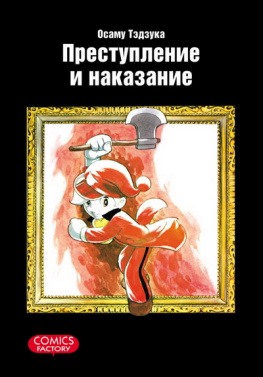Preface
It is the road of every Christian man, who starts from the senses, who is endowed with reason as a dialectical principle which, in the drama of his earthly life, must make a decision between ever increasing participation and eternal defection.
Erich Auerbach, Dante, Poet of the Secular World
Dostoevsky's work represents a life-long meditation on the same few themes, motifs, and figures. The love triangle, for instance, with all its ambiguities of pride and humiliation, outward magnanimity, and inner rivalry, entered his work with his very first book, Poor Folk, finished in 1845, when he was twenty-four. Some ten years later, after passing through many of his early stories ( The Landlady, A Faint Heart, White Nights ), the motif entered the writer's own life in the form of his friendship with the Isaev family in Semipalatinsk and his later courtship of the widowed Marya Dmitrievna Isaev. Marya Dmitrievna eventually became his first wife, but before accepting his proposal she hesitated for a long time between Dostoevsky and a young schoolteacher by the name of Vergunov. Dostoevsky thus got to play two rolesthe family friend who falls in love with the mistress of the house, and then the older rival of a handsome young suitor. The various moves of this elaborate game are detailed in the letters he wrote at the time, which read like pages from one of his own epistolary tales. So he found himself in situations he had already portrayed and would portray again and again in his later novels, culminating in the three (or four) interlocking love triangles of The Brothers Karamazov. This close exchange between life and literature, with literature sometimes strangely anticipating life, is a Dostoevskian feature.
The figure of the "dreamer" also entered Dostoevsky's work with Poor Folk, took a central part in much of his early writing, both fiction and journalism, re-emerged quite changed in Notes from Underground (1864), and continued to appear in virtually all his later work. Mikhail Bakhtin notes in Problems of Dostoevsky's Poetics: "Dostoevsky made very wide use of the artistic possibilities of the dream in almost all its variations and nuances. Indeed, in all of European literature there is no writer for whom dreams play such a large and crucial role as Dostoevsky." We must distinguish, however, between the dreamer and the dream, because dreaming takes two main forms in Dostoevsky. The first is the form of a reverie produced by the dreamer, who longs to transform the squalid reality around him into something nobler, loftier, more beautiful. The dreamer is a fervent idealist, a great reader of German romantic poetry, but his consciousness is isolated and he usually ends badly. Reality triumphs. Yet the dreamer's aspirations receive a backhanded vindication: aesthetically he is right; art and sensibility are exalted in his person above the meanness of the world. The bubble of this sort of romantic dreaming, which Dostoevsky himself indulged in as a young liberal of the 1840s, was definitively pricked in Notes from Underground . There the dreamer becomes a far more complex and contradictory figure; his tone changes from sentimental idealism to bitter sarcasm, much of the sarcasm directed against himself and his own former dreams: "... to tell long stories of how I defaulted on my life through moral corruption in a corner, through an insufficiency of milieu, through unaccustom to what is alive, and through vainglorious spite in the undergroundis not interesting, by God; a novel needs a hero, and here there are purposely collected all the features for an anti-hero... Isolated consciousness has recognized its isolation. This recognition marked all of Dostoevsky's work after Notes .
The second form dreaming takes in Dostoevsky is that ofan unexpected and intense vision, which comes to the dreamer in sleep as a gift or a final revelation, a "living image" thatawakens him to a truth he had not suspected or had not understood before. Such are Alyosha's dream of the messianic banquet and Mitya's dream of "the wee one" in The Brothers Karamazov . These are confirming, saving dreams. They have a negative counterpart, ultimately serving the same purpose, in the nightmares of Raskolnikov and Svidrigailov in Crime and Punishment , of Stavrogin in Demons , and finally in Ivan Karamazov's "hallucination" of the devil.
With his second book, The Double (1846), another key motif of Dostoevsky's work appears. The story tells about the emergence of a "Mr. Golyadkin Jr." in the government office where the petty clerk Golyadkin serves, a parody and rival of himself who eventually drives him mad. Mr. Golyadkin Sr. is a proud man and keeps aloof from his fellow clerks; his double is the reverse. Golyadkin Sr. says of him: "He has such a playful, nasty character... He's such a scoundrel, such a fidget, a licker, a lickspittle," but then adds, "such a Golyadkin." Here Dostoevsky first came upon the surprising truth that pride, far from unifying and fortifying the person, as we might think, is the source of all inner divisions. In The Double it literally splits Mr. Golyadkin in two. Dostoevsky did not repeat this bold artistic experiment, which in fact never satisfied him, but the motif of the double occurs in subtler forms throughout his work. It raises by implication the question of human unity, the oneness of the person and of mankind, which Dostoevsky explored all his lifepolitically in his involvement with revolutionary groups in the 1840s, spiritually in his subsequent religious meditations.
The phenomenon of the double in Dostoevsky's work is not subject to purely psychological explanation. There is always a social nexus, an outer and collective world that is reflected in or impinges upon the inner, personal world. In The Double this nexus is the administrative bureaucracy introduced by the emperor Nicholas I, in which, as the critic Konstantin Mochulsky wrote, "the schema of human values was replaced by the table of ranks." Administrative unity is external and imposed; behind it there is a growing disintegration of human life. To dramatize this disunity, Dostoevsky often resorts to the device of the "scandalous feast" or "inappropriate gathering" (as one book of The Brothers Karamazov is entitled). So he does with the farewell party in Notes from Underground, the funeral dinner for Marmeladov in Crime and Punishment , and, more scandalous still, the gathering of all the main characters of Demons in Varvara Petrovna's drawing room. "Here," says Bakhtin, "everything is unexpected, out of place, incompatible and impermissible if judged by life's ordinary 'normal' course." Things usually hidden are brought to light, unspeakable words are spoken, people are exposed, denounced, humiliated; in tone and effect these scenes are somewhere between wild farce and hysteria. They are marked by a particular shamelessness.
Scandal scenes are loud and chaotic, but the true scandal, the "scandalous victim," is silent or inarticulate in Dostoevsky. Separation from "what is living" leads to violence against what is living, to a violation of the living, to violated innocence. Most often the victim is a child; in both Crime and Punishment and Demons it is a sexually abused little girl. Among all the thinkers, talkers, and writers who populate Dostoevsky's works, the child stands mute, unable to comprehend or protest. Certain women play a similar roleSonya Marmeladov, for instance, and the half-mad Marya Lebyadkin. Through them the theme deepens until it touches, in Mochulsky's words, on "the eternal feminine principle of the world, the mystical soul of the earth."

